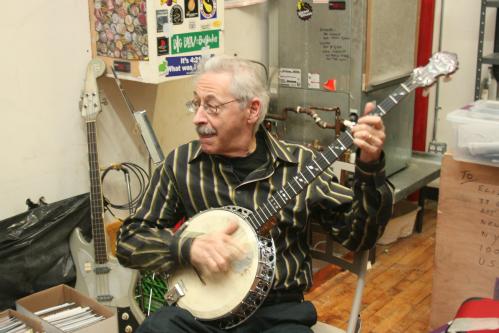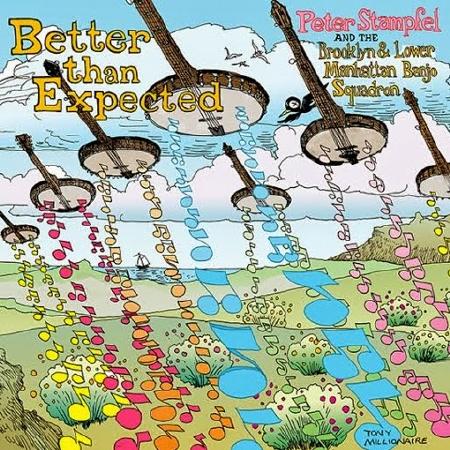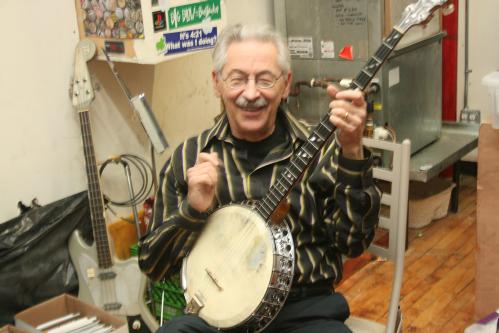|


In Part One of our interview, we talk about Peter's latest
album, Better Than Expected, by Peter Stampfel
& the Lower Manhattan And Brooklyn Banjo Squadron. That
segues into a history of the banjo in American popular music.
Q: Let’s talk about the new album first. My understanding
is that this was an experiment to see how many banjos you
could have playing at a time without it turning into total
anarchy.
Peter: Well, then again, anarchy works. (laughs) The question
is, how far can you go? Having a limited number of musicians
in a band makes everything much easier. Once you get beyond
four, it starts getting tricky. Up to four, it’s fairly
easy for everyone to hear everyone else. Once you get five,
five is a lot harder than four. And as you add numbers,
the difficulty becomes exponentially greater. Six is a lot,
lot harder than five, and seven is a lot, lot harder than
that.
In the real world, I keep running into people I play with
and want to include in whatever project’s going down.
This is the dao of the world. This is what I’m constantly
confronted with. Oh, I gotta play with this guy, gotta play
with this guy too. So at a certain point, you go, okay,
one more and that’s it, and then finally I just said,
fuck it, I’m not going to restrict the upper number.
Like I write in the liner notes, half the potential members
of the banjo squadron weren’t available when the tiny
window for recording revealed itself. So we’ve never
had more than five banjo players going at once, despite
the fact that there were ten or more potential people I
wanted. And my idea was, after a certain point, say after
five, I was going to split the banjos into two groups, A
and B. This album is an experiment on several levels. I’m
not doing it so certain things will happen; I’m doing
it to find out what happens if we do it. When you approach
an artistic project with the idea, “I don’t
know, I have no fucking idea what’s going to happen,”
it just opens up everything wonderfully. Instead of having
some sort of formulaic, didactic plan. So I was going to
split the banjos into two bunches, and have the first group
play on four beats or eight beats, or two beats and one
beat, and have the second group play on two, four, eights,
sixteenths. And have group A play four beats, group B play
four beats, and then everybody play four beats. The idea
being, once you get that many people, it constructs things
so that despite the crowd, the potential number of people
playing at any one time forces some people not to play but
to listen. Because listening is the whole point of being
in a band. That’s why three or four people is the
ideal band, especially when you’re improvising, because
they can all listen to each other. Listening is just incredibly
critical when you’re free-forming. Otherwise you get
mud. So the idea here was to have some kind of magic happening
with multiple people where half the group was being forced
to listen to the other half at least part of the time.

Q: The banjo is an interesting instrument, though,
because if you have two guitars, you can play harmonies,
like the Allman Brothers. Banjos don’t really do that.
Peter: Oh they can, they can indeed. In fact harmonies
are my favorite way of improvising. If you’re harmonizing
with somebody, you’re automatically in rhythm. You
can’t possibly harmonize with someone and not be following
the same beats. I love fifths, I love fourths, I love weird-assed
harmonies like a fifth above and a fourth below. I like
harmonies that ideally make the hair on the back of your
neck stand up.
Q: It seemed to me like the banjo fell out of favor
for a long time and recently they’ve been revived
by all these alt-Americana bands like Mumford & Sons
made them chic again. But I know most folk purists don’t
like that band. How do you feel about it?
Peter: Banjos were the rock and roll of the 19th Century.
Banjos were absolutely massive. There’s the cliché
of the cowboy with a guitar, but guitars in the 19th Century
were an upper middle class woman’s parlor instrument.
Guitars didn’t become popular until the Spanish-American
War. The lower class and lower middle class soldiers picked
up guitars in Cuba and brought them back to the U.S., and
a substantial number of black musicians at that time laid
their banjos and fiddles down and picked up a guitar. I
mean, guitars are fucking amazing things, you can see why
they became so popular, especially with blues musicians.
Then the four-string banjos came into popularity because
of ragtime music and early jazz, and you had to compete
with a bunch of horns, so you needed resonators and flat
picks. Then banjos began fading again in the 1930’s
when electric guitars came into vogue. They never amplified
banjos, oddly, but guitars and amplification were a marriage
made in heaven. By the 1930’s, your professional banjo
players had to wear clown drag. Even Uncle Dave Macon had
a real clown shtick going. And you had country people like
Grandpa Jones and Stringbean who wore bib overalls and low-cut
pants and all had a comedy thing going, because banjos just
weren’t taken seriously at that point.

Q: Except for bluegrass.
Peter: Well, that’s an interesting story. I had a
friend in Milwaukee who introduced me to folk music in 1957.
This guy named Ron Tiafan who was from Texas, he was going
to Marquette University studying dentistry, but he played
5-string banjo. He played on Louisiana Hayride, which was
a big country radio show, and he played in a talent show
at Marquette. He had a top hot with the top ripped off and
ripped jeans, it was a strange meme of banjo playing being
equated with being a yokel clown.
Bluegrass music actually came into being based roughly
on what Charlie Poole was doing with his finger-picking,
and he played like that because Charlie Poole played baseball,
and he was too macho to use a glove. So he caught a fly
ball with his bare hand once and broke his fucking hand,
and it set into a position where he could do three-finger
picking but that’s about all he could do. He couldn’t
bend his hand to hold a pick or hit any more strings. And
then Flatt & Scruggs came along with that same finger-picking
style, about 1939 or so, and that became bluegrass.
Pete Seeger is about one-half responsible for the banjo’s
popularity among non-Southerners. Back in the Fifties when
Pete Seeger became more widely known, he introduced the
banjo to a whole new audience of urban listeners and it
never really died out since then. And I’d say there’s
been a steady growth with an occasional growth spurt. But
I’d say that the popularity of banjos, if you were
going to draw a chart, number of banjos sold and people
playing them, I think your chart would be going steadily
upwards from the Fifties. And people are still picking up
on it. What’s that pop record? “Best Day Of
My Life.” That has a really cool banjo sound in there.
It’s got a nice banjo part. A perfect example of how
excellently finger-picked banjo can be incorporated into
contemporary rock ‘n’ roll. I see on Youtube
all the time more and more people playing banjo along with
the standard rock and roll instruments, which I’m
very happy about.
 Continue
to Peter Stampfel, Part Two Continue
to Peter Stampfel, Part Two
back to jerseybeat.com
l back to top
JerseyBeat.com
is an independently published music fanzine
covering punk, alternative, ska, techno and garage
music, focusing on New Jersey and the Tri-State
area. For the past 25 years, the Jersey Beat music
fanzine has been the authority on the latest upcoming
bands and a resource for all those interested in
rock and roll.
|
|
|

